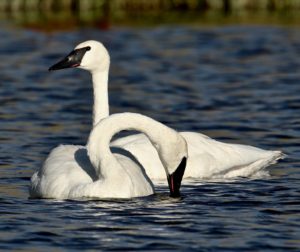By Deb Drain

Trumpeter Swans (Cygnus buccinator) is one of the most identifiable waterfowl found in the Island Park area. They are named after their call, which sounds like a trumpet. Trumpeter Swans are entirely white, with black bills, feet, and legs. They are the largest waterfowl in North America and one of the largest flying birds in the world. Trumpeter Swans can be up to 5’ in length, with wingspans of up to 8 feet, and can weigh up to 30 lbs. Due to their size, they need open water on which to run to gain the speed and lift needed to become airborne.
Trumpeter Swans live and breed in wetlands, shallow ponds, lakes, and slow rivers. They require open water year-round to access their primary food source, aquatic plants, of which a mature adult can consume up to 20 pounds/day. Trumpeter Swans are also very sensitive to human disturbance. Although they have become somewhat “tolerant” of people in the YNP and IP areas, giving them their space is always best.

Trumpeter Swan population recovery is one of our most successful conservation efforts. By 1932 it was estimated that the total remaining Trumpeter population was the 70 birds that resided at Red Rocks Lake, MT. The North American population is now estimated at 46,225 birds, with approximately 500 birds in the tri-state area of MT, ID, and WY. Unfortunately, they still face threats from climate change, habitat loss, and lead. Trumpeters can be seen in the IP area at Swan Lake, Harriman State Park, the Henry’s Fork of the Snake and Buffalo Rivers, Yellowstone National Park, and Red Rocks National Wildlife Refuge (Centennial Valley, MT). If you’re lucky enough to see these magnificent birds enjoy your time with them and say a little thank you to those who made it possible.
